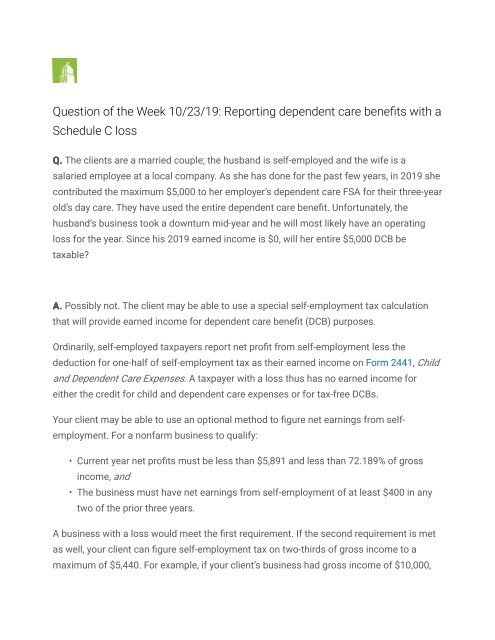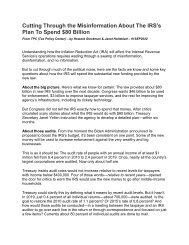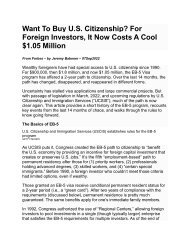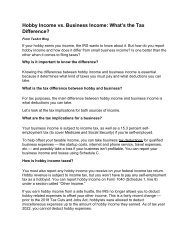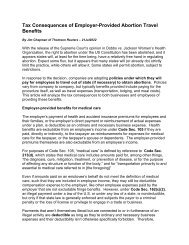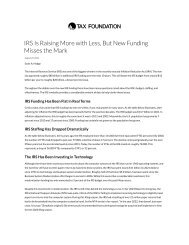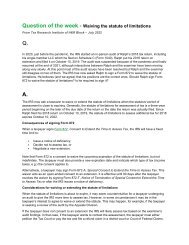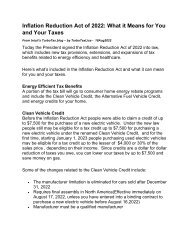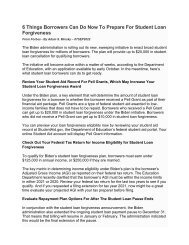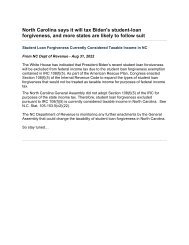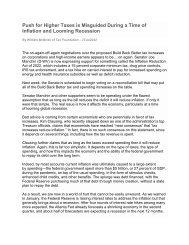Create successful ePaper yourself
Turn your PDF publications into a flip-book with our unique Google optimized e-Paper software.
Question of the Week 10/23/19: Reporting dependent <strong>care</strong> benefits <strong>with</strong> a<br />
<strong>Sch</strong>edule C <strong>loss</strong><br />
Q. The clients are a married couple; the husband is self-employed and the wife is a<br />
salaried employee at a local company. As she has done for the past few years, in 2019 she<br />
contributed the maximum $5,000 to her employer’s dependent <strong>care</strong> FSA for their three-year<br />
old’s day <strong>care</strong>. They have used the entire dependent <strong>care</strong> benefit. Unfortunately, the<br />
husband’s business took a downturn mid-year and he will most likely have an operating<br />
<strong>loss</strong> for the year. Since his 2019 earned income is $0, will her entire $5,000 DCB be<br />
taxable?<br />
A. Possibly not. The client may be able to use a special self-employment tax calculation<br />
that will provide earned income for dependent <strong>care</strong> benefit (DCB) purposes.<br />
Ordinarily, self-employed taxpayers report net profit from self-employment less the<br />
deduction for one-half of self-employment tax as their earned income on Form 2441, <strong>Child</strong><br />
and Dependent Care Expenses. A taxpayer <strong>with</strong> a <strong>loss</strong> thus has no earned income for<br />
either the credit for child and dependent <strong>care</strong> expenses or for tax-free DCBs.<br />
Your client may be able to use an optional method to figure net earnings from selfemployment.<br />
For a nonfarm business to qualify:<br />
• Current year net profits must be less than $5,891 and less than 72.189% of gross<br />
income, and<br />
• The business must have net earnings from self-employment of at least $400 in any<br />
two of the prior three years.<br />
A business <strong>with</strong> a <strong>loss</strong> would meet the first requirement. If the second requirement is met<br />
as well, your client can figure self-employment tax on two-thirds of gross income to a<br />
maximum of $5,440. For example, if your client’s business had gross income of $10,000,
optional self-employment income would be the maximum $5,440, which is less than<br />
$6,666 ($10,000 × 2/3).<br />
For DCB purposes, earned income to include on Form 2441 is equal to the optional selfemployment<br />
income less one-half of self-employment tax. Continuing <strong>with</strong> the example,<br />
earned income would be $5,024 ($5,440 – $416) and the entire $5,000 DCB would be taxfree.<br />
If the client doesn’t qualify for the optional method the DCB would be taxable.<br />
The optional method is usually beneficial for taxpayers, but the tax savings as well as any<br />
changes to refundable credit calculations (earned income credit and additional child tax<br />
credit) should be weighed against the self-employment tax obligation. The optional<br />
method may be used for a maximum of five years.<br />
See the Form 2441 Instructions and <strong>Sch</strong>edule SE Instructions.<br />
H&R Block Info<br />
Originally published in the 10/23/19 edition of TAX in the News<br />
Legal & IRS Information<br />
IRS Publications<br />
Pub. 503, <strong>Child</strong> and Dependent Care Expenses<br />
IRS Forms/Instructions<br />
<strong>Sch</strong>edule SE (Form 1040) Instructions<br />
Form 2441 Instructions<br />
Copyright info: ©2019 The Tax Institute at H&R Block. All rights reserved. If you would like<br />
to publish or use any part of this content, you must receive permission in writing prior to<br />
use.


